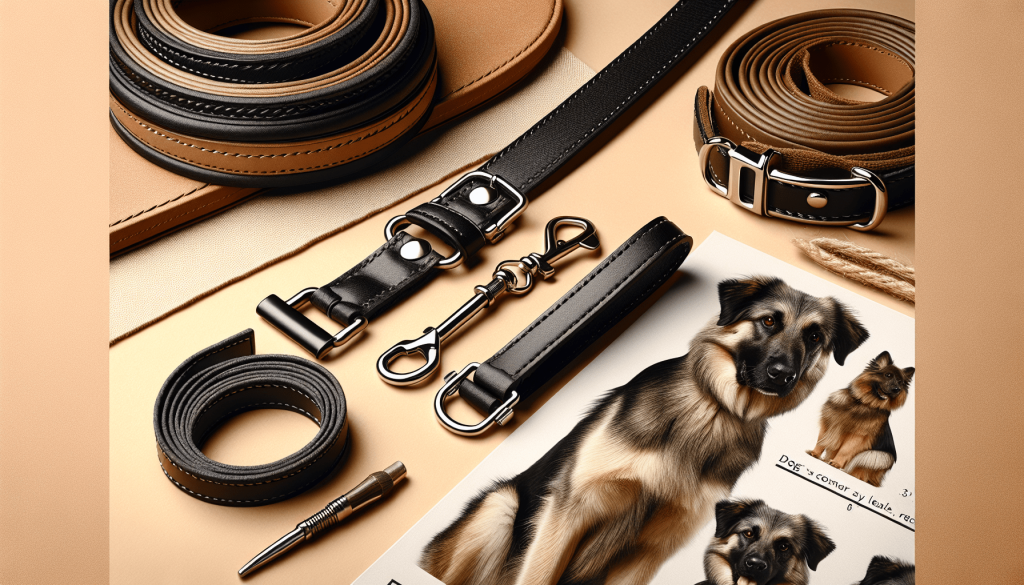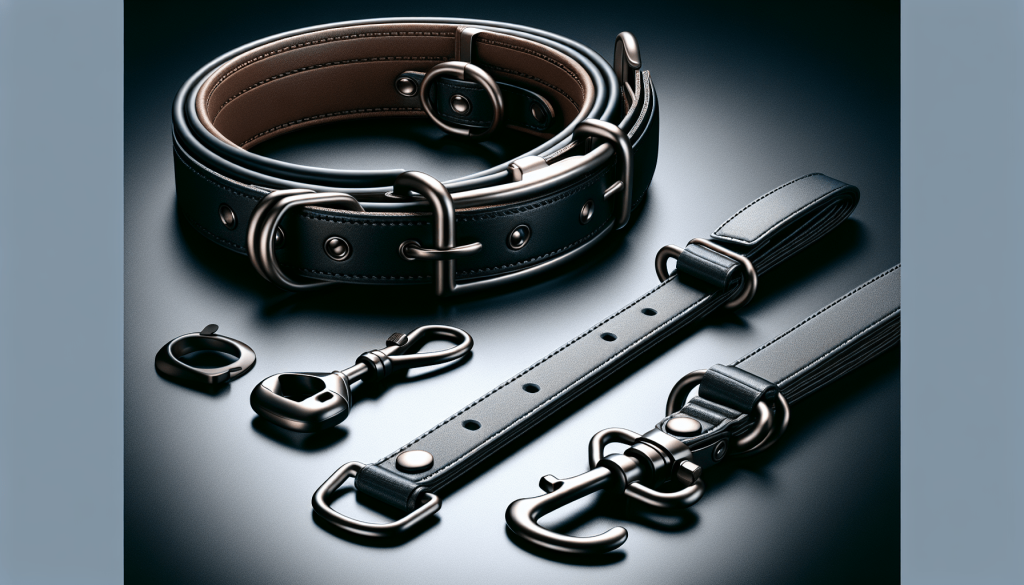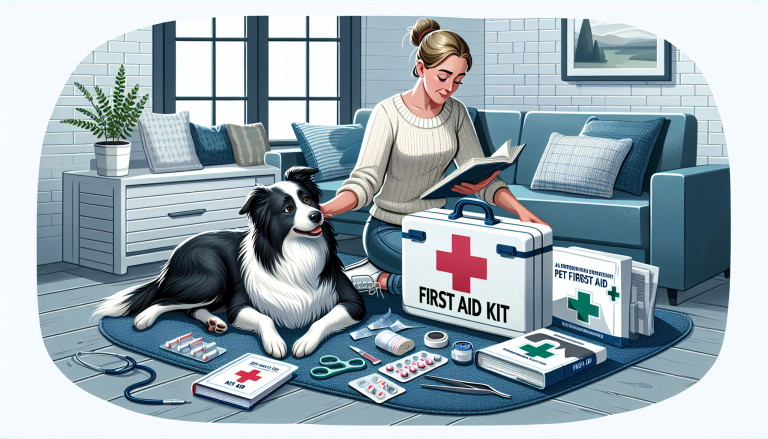Looking to upgrade your furry friend’s accessories? Choosing the right dog collar and leash is crucial for your pup’s comfort and safety, but with so many options on the market, it can be overwhelming to make the right choice. Don’t worry, we’ve got you covered! In this article, we’ll guide you through the factors to consider when selecting a collar and leash, from sizing to materials, so that you can make an informed decision that perfectly suits your four-legged companion.
Table of Contents
ToggleConsider Your Dog’s Size and Breed
Measure your dog’s neck size
When choosing a dog collar, the first step is to measure your dog’s neck size accurately. A collar that is too tight can cause discomfort and even injury, while a collar that is too loose may slip off. To measure your dog’s neck size, use a soft measuring tape and wrap it around the base of your dog’s neck, where the collar will sit. Make sure to measure snugly but not too tight. Note down the measurement to help you select the right collar size.
Consider your dog’s weight and strength
Another important factor to consider when choosing a collar is your dog’s weight and strength. Larger, stronger dogs may require a sturdier collar that can withstand their pulling or lunging behavior. On the other hand, smaller dogs may benefit from a lighter and more flexible collar. It’s essential to choose a collar that can provide the necessary comfort and support for your dog’s size and strength.
Take into account your dog’s breed characteristics
Different dog breeds have varying neck sizes, strengths, and behavioral characteristics. Considering your dog’s breed can help you narrow down your options when choosing a collar. For example, sighthounds like Greyhounds have long, slender necks that require specific collar designs to prevent injury. Breeds with short muzzles, such as Bulldogs, may benefit from a harness instead of a collar to avoid pressure on their sensitive necks. Understanding your dog’s breed characteristics will help you make an informed decision.
Evaluate Your Dog’s Temperament and Behavior
Assess your dog’s obedience level
Assessing your dog’s obedience level is essential when selecting a collar. If you have a well-trained dog who responds to commands reliably, a regular buckle collar may suffice. On the other hand, if your dog is still undergoing training or tends to be less obedient, you may want to consider a training collar, such as a martingale or a prong collar, to aid in control and correction during walks.
Consider your dog’s energy level
Your dog’s energy level should also be taken into consideration when choosing a collar. High-energy dogs may benefit from a collar that allows for more freedom of movement, such as a harness or a retractable leash. These options give them the ability to explore and burn off energy while keeping them safely restrained. Low-energy dogs, on the other hand, may be better suited to a standard leash and collar combination for casual walks.
Determine if your dog pulls or lunges on walks
If your dog tends to pull or lunge during walks, it’s crucial to select a collar that provides proper control and prevents injury to both you and your dog. A harness can distribute the pulling force across the dog’s body, reducing strain on the neck and throat. Alternatively, a head halter or a no-pull harness can help discourage pulling behavior by redirecting your dog’s attention and providing gentle resistance.
Decide on the Material and Design
Choose the collar material (nylon, leather, etc.)
The material of the collar plays a significant role in your dog’s comfort and durability. Nylon collars are lightweight, affordable, and come in a variety of colors and designs. They are easy to clean and maintain, making them a popular choice for everyday use. Leather collars, on the other hand, are more durable and can develop a beautiful patina over time. They are suitable for dogs with sensitive skin and provide a classic and stylish look. Consider your dog’s needs, your preferences, and the collar’s intended use when choosing the material.
Consider the leash material and length
Just like collars, leashes are available in different materials, each with its own benefits. Nylon leashes are lightweight and come in various colors and patterns. They are easy to clean, making them a practical choice for everyday walks. Leather leashes are sturdy and provide a comfortable grip. They are favored by dog owners who value durability and a traditional look. The length of the leash depends on your dog’s training, your walking environment, and your personal preference. Shorter leashes offer more control, while longer leashes give your dog more freedom to explore.
Decide on the design and style of the collar and leash
Collars and leashes come in an array of designs and styles to match your dog’s personality and your own taste. Whether you prefer a vibrant, patterned collar or a simple, classic design, there are countless options to choose from. You can also find matching collar and leash sets for a cohesive and stylish look. Ultimately, the design and style of the collar and leash should reflect your dog’s individuality while also ensuring comfort and functionality.
Ensure Proper Fit and Comfort
Measure your dog’s neck for collar sizing
To ensure a proper fit, it’s crucial to measure your dog’s neck accurately. As previously mentioned, use a soft measuring tape and wrap it around the base of your dog’s neck, snugly but not too tight. Refer to the sizing guide provided by the manufacturer of the collar you’re considering and select the appropriate size based on your dog’s measurement. Avoid choosing a collar that is too loose or too tight, as it can lead to discomfort, chafing, or even injury.
Check the collar’s width for comfort
In addition to the neck size, the width of the collar is also important for your dog’s comfort. A narrow collar may dig into your dog’s neck and cause discomfort, while a wide collar provides better distribution of pressure. Consider your dog’s breed and individual needs when choosing the appropriate width. As a general guideline, small dogs may benefit from a narrower collar, while larger dogs may require a wider one for adequate support.
Ensure the leash length is appropriate
The length of the leash should be suitable for both your dog’s behavior and your walking environment. A shorter leash can provide better control, especially in busy or crowded areas, while a longer leash allows your dog more room to roam in open spaces. Consider your dog’s training level and how they respond to commands when choosing the leash length. It’s important to strike a balance that ensures safety, control, and freedom of movement for both you and your dog.
Consider Special Features and Functions
Look for reflective or glow-in-the-dark materials
If you often walk your dog during low-light conditions, having a collar and leash with reflective or glow-in-the-dark materials can greatly enhance visibility and safety. These special features help make your dog more visible to passing vehicles and pedestrians, reducing the risk of accidents. Look for collars and leashes with reflective stitching or integrated LED lights to ensure maximum visibility and peace of mind during nighttime walks.
Consider a collar with a personalized ID tag
A collar with a personalized ID tag is an essential feature for every dog. In case your dog gets lost, having their name and your contact information on their collar increases the chances of a safe return. Many collars now come with built-in ID tag holders or customizable embroidery options. This convenient feature eliminates the need for additional tags or jingling noise, while ensuring that your dog can be easily identified and reunited with you.
Explore options with built-in leash handles
Some collars and harnesses offer built-in leash handles, also known as traffic handles or control handles. These handles are typically located near the neck area and provide an extra level of control in certain situations. For example, you can use the handle to keep your dog close in crowded areas, during training sessions, or when crossing busy roads. The leash handle offers a secure and comfortable grip, allowing you to maintain control over your dog without needing to grasp the leash directly.
Think About Training and Control Needs
Consider a training collar for obedience training
If you’re working on obedience training with your dog, a training collar can be a valuable tool. Martingale collars and prong collars are commonly used for training purposes. Martingale collars are designed to provide control without choking or causing harm to your dog. They tighten when your dog pulls but release when there’s no tension. Prong collars, when used correctly and under the guidance of a professional, can help correct pulling behavior by applying pressure evenly around the neck. It’s important to consult with a professional trainer before using training collars to ensure proper and humane usage.
Look for a harness for better control
Harnesses are a popular choice for dog owners seeking better control during walks, especially for dogs that tend to pull or have respiratory concerns. Harnesses distribute the pulling force across the dog’s chest and shoulders, reducing strain on the neck and throat. They provide better control, prevent choking, and are often recommended for brachycephalic breeds, such as Boxers or Bulldogs. When choosing a harness, opt for one with adjustable straps to ensure a snug and secure fit.
Consider a martingale collar for dogs who try to slip out
For dogs who have a knack for slipping out of their collars, a martingale collar can be a suitable option. Martingale collars have an extra loop that tightens when the dog pulls, preventing them from escaping. They offer more control than regular buckle collars without the potential harm associated with traditional choke collars. Martingale collars can be particularly useful for dogs with narrow heads, such as Greyhounds or Whippets, as they prevent slipping while providing comfort and safety.
Choose the Right Collar Type
Select a buckle collar for everyday use
Buckle collars, also known as flat collars or snap collars, are the most commonly used collars for everyday walks and identification purposes. They feature a simple buckle mechanism for easy on and off and usually have an adjustable strap for a customized fit. Buckle collars are versatile, comfortable, and suitable for dogs of all sizes and breeds. They come in various materials, widths, and designs, allowing you to choose the perfect collar for your dog’s individual needs and style.
Consider a quick-release collar for safety
Quick-release collars, also known as safety collars or breakaway collars, are designed with a safety feature that allows the collar to break open under pressure. These collars are ideal for dogs who may get caught or snagged during playtime or outdoor adventures. The quick-release mechanism instantly opens the collar, preventing choking or injury. Quick-release collars can provide peace of mind, especially for dogs who spend time unsupervised in fenced-in yards or during off-leash activities.
Choose a choke or prong collar if recommended by a professional
Choke collars and prong collars are controversial tools that should only be used under the guidance and supervision of a professional trainer or behaviorist. Choke collars, also known as chain collars, tighten around the dog’s neck when pulled, providing correction and control. Prong collars, with their metal prongs evenly spaced around the collar, deliver gentle pressure to sensitive areas on the neck to discourage pulling or lunging behavior. It’s essential to ensure proper usage and avoid any potential harm or discomfort to your dog.
Select the Appropriate Leash Type
Choose a standard leash for casual walks
Standard leashes, typically around 4 to 6 feet long, are the go-to choice for casual walks and everyday use. They offer sufficient control while keeping your dog close by your side. Standard leashes are available in various materials, such as nylon or leather, and often come with comfortable handles for a secure grip. Consider the handle design, material, and length that feel most comfortable for you, as well as the durability and strength required for your dog’s size and strength.
Consider a retractable leash for more freedom
Retractable leashes, also known as flexi leashes, feature a long nylon cord housed in a plastic handle. These leashes allow your dog to explore and roam within a specific radius, giving them more freedom to move around while still under your control. With the push of a button, the leash can extend or retract, providing convenience and flexibility during walks. Retractable leashes are particularly useful in open spaces where there are no safety hazards or crowded areas where more control is necessary.
Opt for a hands-free leash for active individuals
Hands-free leashes offer convenience and freedom of movement for active individuals who enjoy jogging, running, or hiking with their dogs. These leashes typically have an adjustable waist belt or shoulder strap, allowing you to attach it around your waist or across your body, leaving your hands free. Hands-free leashes are designed to provide a comfortable and secure attachment, enabling you to enjoy outdoor activities without worrying about holding onto a traditional leash.
Consider Your Budget
Set a budget for the collar and leash
Before purchasing a collar and leash, it’s important to set a budget that aligns with your financial means. Collars and leashes are available at various price points, depending on the design, materials used, and additional features. While it’s essential to choose products of good quality, setting a budget will help ensure that you find options that meet your needs without overspending.
Compare prices and quality
Once you have set a budget, it’s time to compare prices and quality. Research different brands, read customer reviews, and visit pet supply stores or online shops to compare prices and assess the quality of different collars and leashes. Remember that higher prices do not always guarantee better quality, and sometimes more affordable options can provide the functionality and durability you need. Look for products that strike a balance between value for money and reliable quality.
Consider long-term durability and value for money
When considering your budget, it’s essential to think about long-term durability and value for money. Investing in a high-quality collar and leash may save you money in the long run, as they are less likely to wear out or break easily. Cheaper options may need to be replaced more frequently, resulting in higher long-term costs. However, it’s important to find the right balance for your specific situation and choose products that offer the durability and value that suit your needs and budget.
Seek Recommendations and Read Reviews
Ask for recommendations from dog owners
One of the best ways to gather information about different collars and leashes is by asking for recommendations from other dog owners. Reach out to friends, family members, or fellow dog enthusiasts and inquire about their experiences with specific brands or types of collars and leashes. Hearing firsthand accounts and recommendations can provide valuable insights and help you make an informed decision.
Read online reviews and ratings
In addition to personal recommendations, reading online reviews and ratings can provide a wealth of information. Visit reputable websites or online marketplaces to read reviews from other pet owners who have purchased and used a particular collar or leash. Pay attention to the overall rating as well as individual comments about durability, fit, comfort, and functionality. These reviews can give you a better understanding of the pros and cons of different products.
Consider testimonials from trusted sources
Look for testimonials from trusted sources, such as professional trainers, veterinarians, or reputable dog organizations. These experts often offer insights into the best collars and leashes for different breeds, temperaments, and training needs. Their expertise and experience can guide you in making an informed decision and ensure that you choose a collar and leash that align with your dog’s specific requirements.
By considering your dog’s size and breed, evaluating their temperament and behavior, deciding on the material and design, ensuring proper fit and comfort, considering special features and functions, thinking about training and control needs, choosing the right collar type, selecting the appropriate leash type, considering your budget, and seeking recommendations and reading reviews, you can confidently choose the right collar and leash for your beloved canine companion. Remember that every dog is unique, so finding the perfect combination may require some trial and error. Ultimately, a well-chosen collar and leash will provide comfort, control, and safety during your walks and adventures with your furry friend. Happy exploring!








